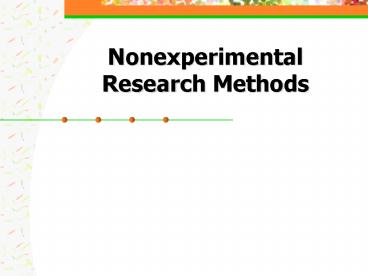Nonexperimental Research Methods PowerPoint PPT Presentation
1 / 23
Title: Nonexperimental Research Methods
1
Nonexperimental Research Methods
2
Archival Research
- Examine previously recorded data to answer a
research question - Census data
- General Social Survey
- Advantages?
- Disadvantages?
3
Observational Research
- Case studies
- Intensive observation of one individual or a
small group of individuals - Cannot generalize beyond original participants
- Naturalistic observation
- Observing behavior in the real world
- Hawthorne effect or reactance
4
Observational Research
- Participant observation
- Observer becomes part of the group being studied
5
Observational Research
- Problem How do you make observations?
- What do you observe?
- When do you observe it?
- How do you record your observations?
- Qualitative Narrative records
- Quantitiative Assign some measurement to
behaviors
6
Interobserver Reliability
- When you use multiple observers, you need to
assess how often they agree - Number of agreements divided by the number of
opportunities to agree - Correlation between observers judgments
7
Correlational Research
- Quantifies the strength of a relationship between
two variables - How does the value of one variable change when
the value of another variable changes?
8
Correlational Research
- Many types of correlations
- Pearson product-moment correlation
- Spearman rank-order correlation
- Advanced techniques
- Multiple correlation
- Path analysis
- Partial correlation
- Point-biserial correlation
9
Pearson product-moment correlation
- Represented by a mathematical score
- Ranges from 1.0 to -1.0
- Absolute value signifies strength of relationship
- Sign signifies nature of the relationship
10
Pearson product-moment correlation
- Strength of a relationship is represented by a
mathematical score - 1.0 Perfect positive correlation
11
Pearson product-moment correlation
- Strength of a relationship is represented by a
mathematical score - 1.0 Perfect positive correlation
- -1.0 Perfect negative correlation
12
Pearson product-moment correlation
- Strength of a relationship is represented by a
mathematical score - 1.0 Perfect positive correlation
- -1.0 Perfect negative correlation
- 0.0 No correlation No relationship!
13
Pearson product-moment correlation
- Which is stronger?
14
Interpreting Correlations
- What does strength of a correlation mean?
- Rule of thumb
- .8 to 1.0
- .6 to .8
- .4 to .6
- .2 to .4
- .0 to .2
- Very strong relationship
- Strong relationship
- Moderate relationship
- Weak relationship
- Weak or No relationship
15
Interpreting Correlations
- Large-scale study of contraceptive use in Taiwan
found that people with more electrical appliances
were more likely to use birth control.
16
Interpreting Correlations
- When we find a relationship between two variables
(A and B), there are three possible explanations - Changes in A cause changes in B
- Changes in B cause changes in A
- Changes in a third variable C cause changes in
both A and B
17
Interpreting Correlations
18
Interpreting Correlations
19
Interpreting Correlations
20
Interpreting Correlations
- Correlations allow us to describe relationships
- Correlations allow us to predict
21
Interpreting Correlations
22
Correlation Coefficient
- Reflects the amount of variability that is shared
between variables - Beware the problem of restricted range
- Correlations are lower because available
variation is restricted
23
Interpreting Correlations
- Coefficient of Determination
- Percentage of variance in one variable that is
accounted for by variance in the other variable - Computed by squaring the correlation coefficient

